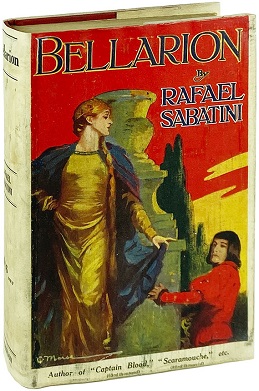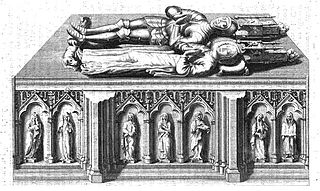
Galeazzo II Visconti was a member of the Visconti dynasty and a ruler of Milan, Italy. His most notable military campaigns were against Pope Gregory XI, around 1367. These battles fought between the papacy and the Visconti family ultimately ended in a peace treaty. Politically active, he expanded the power of his family, where the Visconti first became hereditary rulers of Milan starting in 1349. He is remembered in conjunction with his patronage of intellectuals and writers, from his sponsorship of Petrarch to the founding of the University of Pavia in 1361. Galeazzo II Visconti, and his brother Bernabò, are credited with the institution of the Quaresima Torture Protocol, a vicious means of torture.

The Visconti of Milan are a noble Italian family. They rose to power in Milan during the Middle Ages where they ruled from 1277 to 1447, initially as Lords then as Dukes, and several collateral branches still exist.

Filippo Maria Visconti was duke of Milan from 1412 to 1447. Known to be cruel and paranoid, but shrewd as a ruler, he went to war in the 1420s with Romagna, Florence and Venice in the Wars in Lombardy, but was eventually forced to accept peace under Pope Martin V. He would return to the offensive again where another peace agreement was required to end the fighting. He married twice, the second in 1428 to Marie, daughter of his ally Amadeus VIII. When he died, he was the last of the Visconti male line and was succeeded by Francesco Sforza, husband to his daughter.

Francesco Bussone, often called Count of Carmagnola, was an Italian condottiero.

Valentina Visconti was a countess of Vertus, and duchess consort of Orléans as the wife of Louis I, Duke of Orléans, the younger brother of King Charles VI of France. As duchess of Orléans she was at court and acquired the enmity of the Queen of France, Isabeau of Bavaria-Ingolstadt, and was subsequently banned from the court and had to leave Paris. Due to political animosity, Valentina's husband was murdered in 1407. She died on 4 December 1408.

Bernabò or Barnabò Visconti was an Italian soldier and statesman who was Lord of Milan. Along with his brothers Matteo and Galeazzo II, he inherited the lordship of Milan from his uncle Giovanni. Later in 1355, he and Galeazzo II were rumoured to have murdered their brother Matteo since he endangered the regime. When Galeazzo II died, he shared Milan's lordship with his nephew Gian Galeazzo. Bernabò was a ruthless despot toward his subjects and did not hesitate to face emperors and popes, including Pope Urban V. The conflict with the Church caused him several excommunications. On 6 May 1385, his nephew Gian Galeazzo deposed him. Imprisoned in his castle, Trezzo sull'Adda, he died a few months later, presumably from poisoning.

Bellarion the Fortunate, published in 1926, is an historical novel by Rafael Sabatini. Set at the beginning of the 15th century in northern Italy, it takes place first in the Marquessate of Montferrat and later in the Duchy of Milan. Most of its characters, including Gian Galeazzo Visconti, Gian Maria Visconti, Facino Cane, Filippo Maria Visconti, and Francesco Bussone da Carmagnola, were real historical figures; the scheming title character is the notable exception.

Gian Maria Visconti was the second Visconti Duke of Milan, the son of Gian Galeazzo Visconti and Caterina Visconti. He was known to be cruel and was eventually assassinated. He had no children.

Margaret of Savoy was Marchioness of Montferrat, and a Dominican Sister.

Facino Cane da Casale, born Bonifacio Cane, was an Italian condottiero.
John II Palaeologus was the Margrave of Montferrat from 1338.
Secondotto Palaeologus was the Margrave of Montferrat from 1372 to his death, the third of the House of Palaeologus-Montferrat. His name Secondotto may derive from his being the second Otto to rule Montferrat in his own right, though he would really be Otto III. More probably it is derived from Saint Secundus, the patron saint of Asti, which his father treated as the capital of the marquisate. The Otto may be in honour of Otto, Duke of Brunswick-Grubenhagen, a close ally of his father.
James was the Lord of Piedmont from 1334 to his death. He was the eldest son of Philip I and Catherine de la Tour du Pin. While his father had abandoned his claim to the Principality of Achaea in 1307, James continued to use the princely title and even passed it on to his successors.
John Jacob Palaeologus was the Margrave of Montferrat from 1418 to 1445.
John IV Palaeologus was the Margrave of Montferrat from 1445 until his death.

Margaret of Savoy, also known as Marguerite de Savoie or Margherita di Savoia, was the eldest surviving daughter of Louis I, Duke of Savoy. She was the wife of Margrave John IV of Montferrat, and later the wife of Peter II of Luxembourg, Count of Saint-Pol, of Brienne, Marle, and Soissons.

Caterina Visconti was Duchess of Milan as the second spouse of Gian Galeazzo Visconti, the first Duke of Milan, and was the mother of two succeeding Dukes of Milan, Gian Maria and Filippo Maria Visconti. Caterina served as Regent of Milan from 1402 to 1404, during her elder son's minority, but due to Gian Maria's suspicion of her alleged treason, he had his mother arrested and imprisoned in the castle of Monza, where she was presumably poisoned in 1404.

Yolande Palaiologina or Violant was the Countess consort of Savoy by marriage to Aimone, Count of Savoy. She was the daughter of Theodore I, Marquess of Montferrat, and Argentina Spinola (1303-1356), a Genoese lady, daughter of Opicino Spinola. She received the name Yolande from her paternal grandmother Irene of Montferrat.
Bianca of Savoy was Lady of Milan by marriage to Galeazzo II Visconti.

BeatriceCane, mistakenly known in much of the historiography as Beatrice Lascaris di Tenda but actually a member of the Cane family, was an Italian noblewoman who married first the condottiero Facino Cane, Count of Biandrate and a cousin once removed, and then Filippo Maria Visconti, Duke of Milan, who later had her killed.














